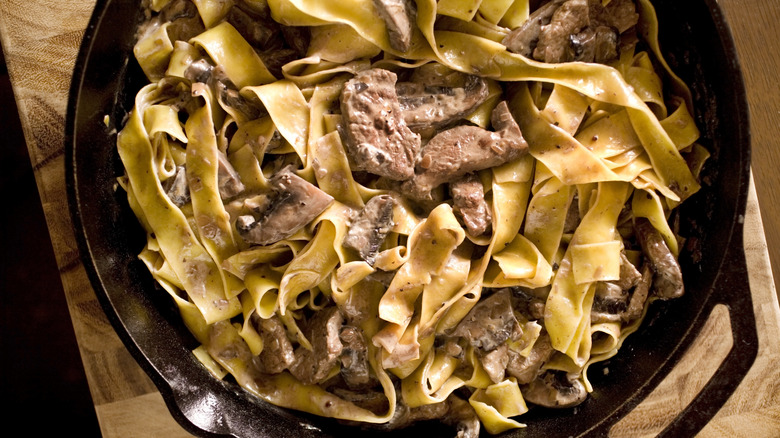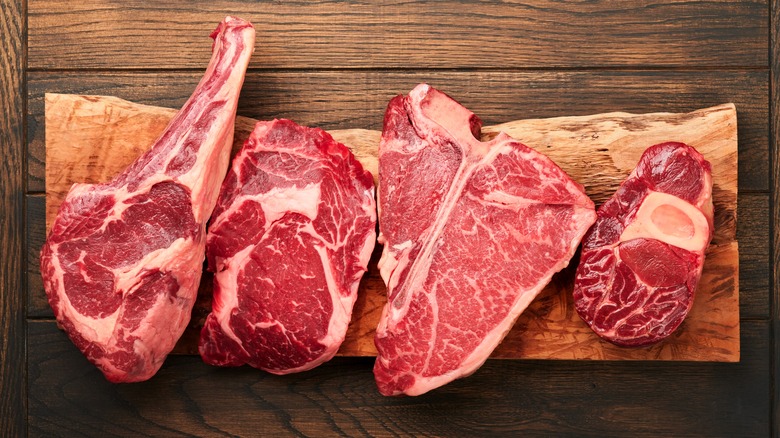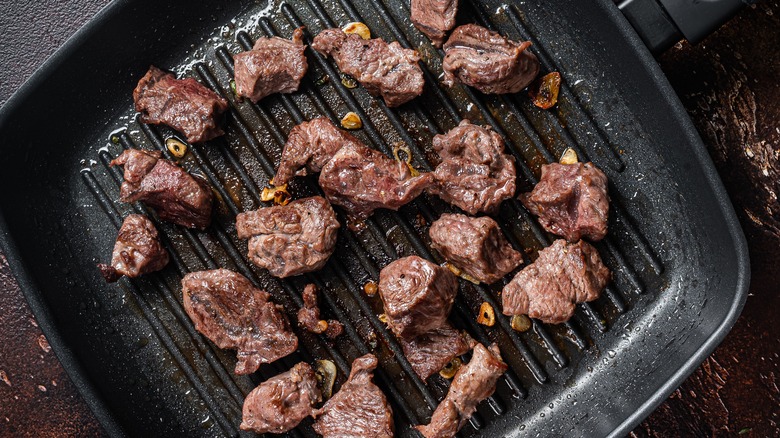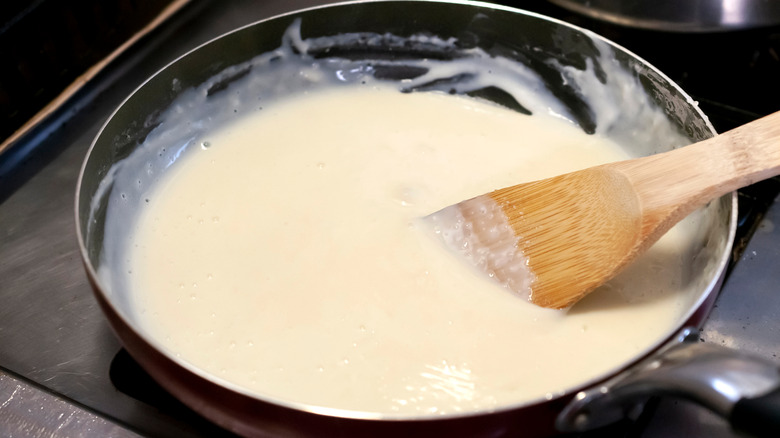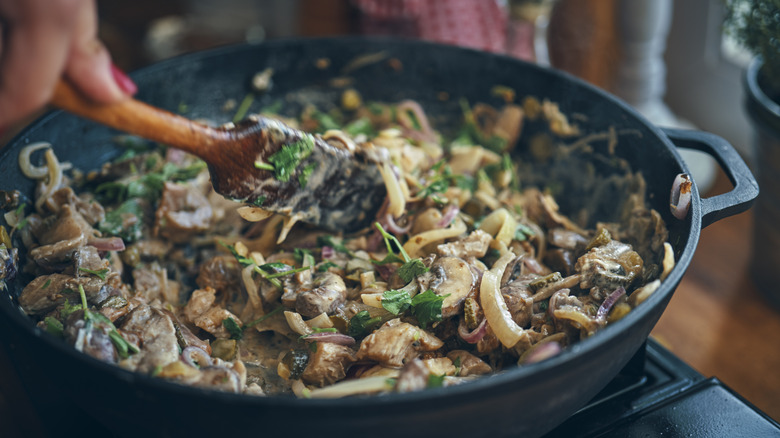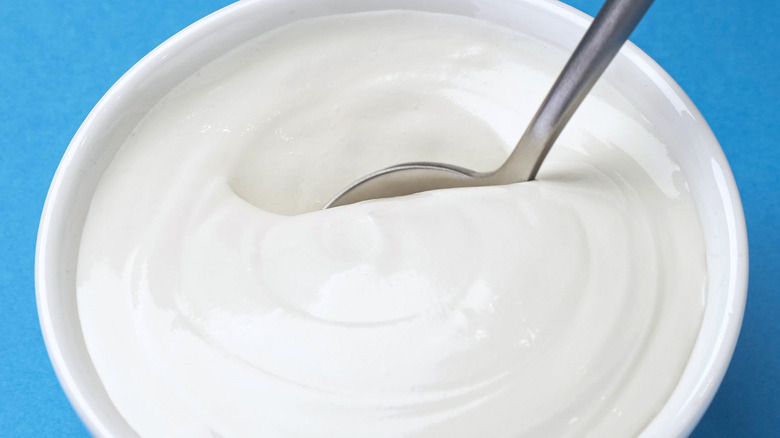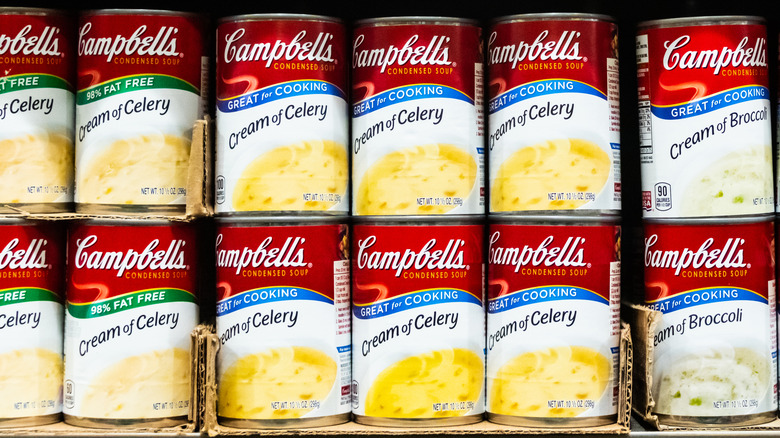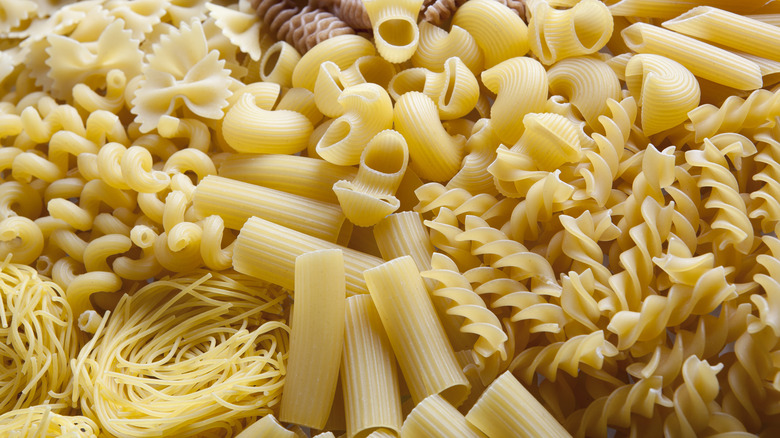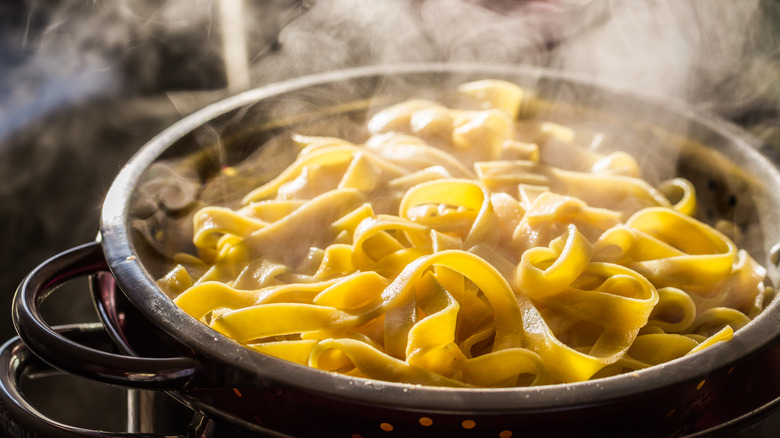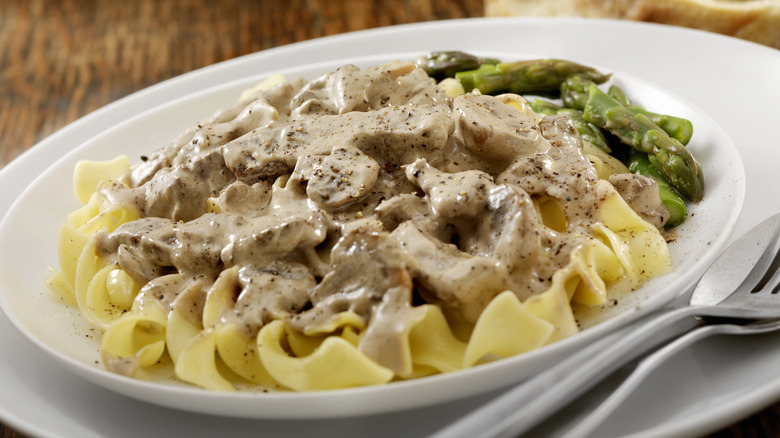Mistakes Everyone Makes When Cooking Stroganoff
Beef stroganoff is a classic American comfort food perfect for warming your body on a cool day or unwinding after a long work week. Despite our love for the dish here in the States, it was actually created in Russia hundreds of years back and involves a complicated history including the infamous Russian czar Ivan the Terrible, a Siberian ruler named Anika Feodorovitch — matriarch of the wealthy Stroganov family — and a series of somewhat shady land deals.
What's important to note is that as these Russians fought over land, they often hired decorated French chefs to prepare their meals. Over time, these chefs came up with a dish including sautéed beef cubes coated in a mustard-and–sour cream sauce and served over either a bed of rich noodles or fluffy mashed potatoes — the classic dish we know as stroganoff today. The dish was so popular that it became a staple meal in St. Peteresburg's Stroganov Palace, which is now a museum and tourist attraction in the Baltics.
First popularized in the U.S. following World War II, stroganoff is a hearty, flavorful dish that packs wonderful umami flavor, delicate cream sauce, the subtle sweetness of sautéed onions, the earthy richness of mushrooms, and the kick of paprika. While it may seem relatively simple to prepare, watch out. There are some special tricks to making the dish and it's surprisingly easy to mess up if you aren't careful! Some of the most common stroganoff cooking mistakes include the following.
Using the wrong meat
Boxed convenience meals and low-cost diner specials dubbed "beef stroganoff" have skewed our perspective on what this hearty classic dish is really supposed to taste like. Sure, you can make versions of mushroom stroganoff that don't contain meat if you follow a plant-based diet — they're great! — and there are also plenty of alternative stroganoffs that include chicken or pork. But, for real stroganoff the way the Russians dreamt it up, you need to use beef, and not just any beef. Hamburger is an okay alternative if you've got nothing else on hand, but the best stroganoff is made with the most tender, succulent cuts of beef, like tenderloin, sirloin, ribeye, filet mignon, New York strip, or top sirloin.
You want to use beef with a tender, mild, and buttery flavor. It should include some marbling and have a decent thickness — if your beef is too thin, it will get lost in the sauce and your stroganoff won't end up packing as much rich, beefy flavor. Cut your beef into inch-sized chunks, slicing across the grain to ensure maximum tenderness. You might also consider a quick marinade to help further tenderize the beef. You can use wine, vinegar, or yogurt alone — aim for 1/2 cup to 1 cup per pound of meat — or mix them together and add a bit of olive oil or spices like cumin, coriander, turmeric, and ginger to further break down the meat's fibers and enhance that wonderful, tender texture.
Not properly searing your meat when cooking it
Once you have your sirloin, tenderloin, or ribeye diced and ready to go, start your stroganoff by putting your meat on to cook. First, generously season it with salt, pepper, and a pinch of paprika. Next, heat a large skillet or frying pan over medium heat until the pan is nice and warm. Don't add the meat until the pan is hot or you won't get as good of a sear — that crispy, caramelized sear is key to a delicious plate of beef stroganoff.
When your pan is hot, add a small amount of oil. You want just enough to coat the bottom but no more. Now, add your meat in a single layer while being careful not to overcrowd the pan. If you place too much meat in the pan all at once, it will steam instead of sear. If you have more beef to cook than room in your pan, cook it in batches. As the meat cooks, avoid the temptation to stir. Those beef chunks need to sit undisturbed on that hot skillet for at least 1 to 2 minutes in order to properly sear. Once one side of the meat is done, turn it over and sear the other side, as well.
Be careful not to overcook the meat! Remember that the beef will continue cooking in the sauce, so it's okay if it's slightly underdone as long as it has that great, delicious outside crust.
Not deglazing the pan
Once your beef is fully cooked, remove it from the pan and set it aside on a plate. If your stroganoff is going to include onions or mushrooms, now is the time to add them to the skillet and cook them. Cremini, white button mushrooms, portobellos, and shiitakes are all great options for stroganoff. You want to slice them and then sauté until tender and a beautiful golden brown. Once your mushrooms and onions are ready, remove them from your pan, but don't start making your sauce. Instead, you need to complete the most important step for making any great beef stroganoff: You need to deglaze your pan.
Deglazing — the act of adding liquid to a hot pan and freeing all the caramelized bits of food stuck to its surface — is a crucial step for adding flavor to any dish and is especially vital for good beef stroganoff. To deglaze your pan, add some minced garlic and let it cook for about 30 seconds or until fragrant. Next, pour in some liquid. You could use a couple tablespoons of dry red or white wine, beef broth, vinegar, a splash of brandy or cognac, or even water in a pinch. Pour in the liquid and then scrape the bottom of the pan with a wooden spoon to release those flavorful, browned bits. That's deglazing! Once it's done, you can continue with your sauce making.
Adding too little or too much flour to the sauce
Once you've deglazed your pan, most stroganoff recipes next call for adding additional liquid to your skillet to make your sauce. Before you do this, you need to add your flour to the skillet. This will help to thicken your sauce and give it that wonderful, creamy consistency we all love so much. For an average recipe, aim to add 1 to 2 tablespoons of flour to the skillet. Sprinkle the flour directly into the pan and then stir it well to soak up that residual liquid and form a thin paste. Be careful to avoid leaving any lumps or clumps in the flour — they won't go away later on. Let the flour cook for about a minute, stirring it constantly. This will help you avoid any sort of weird, raw flour tastes and ensure that you're getting maximum flavor out of the flour.
If you notice the liquid in your pan at this point still seems thin or runny, add more flour or your sauce may not thicken properly. On the flip side, if the flour mixture seems overly thick or paste-like, add a bit of liquid to thin it down some more. Once the flour is the right thickness and is fully cooked, it's time to add any additional liquids. Stir everything together until well mixed and then begin adding your other sauce ingredients like mustard and paprika.
Not adding Worcestershire sauce to your dish
In addition to salt and pepper and paprika, a great stroganoff needs other spices and flavors. Garlic, Dijon mustard, nutmeg, thyme, red pepper flakes, and bay leaves are all excellent additions, but don't stop there. The one secret ingredient your stroganoff is likely missing that will take it from average to extraordinary is a dash or two of Worcestershire sauce. Originally created in 1835 by chemists John Lea and William Perrins of Worcester, England, the sauce was originally made as part of an attempt to replicate the recipe for a rich, savory, and umami-infused sauce popular at the time in India. The original fermented version of the sauce they created contained anchovies, tamarind, vinegar, and various spices and is relatively unchanged in flavor to this day.
Stroganoff and Worcestershire sauce are an ideal duo. The dark, smoky sauce gives the dish depth and robust, umami savoriness, layers of flavor, and a slightly acidic tang that helps to perfectly balance the creaminess of the dish. Be careful with how much you add. It's potent and a little goes a long way. Start with a teaspoon and work your way up from there if you really enjoy the flavor of the sauce.
Don't have any Worcestershire on hand? Soy sauce, tamari, balsamic vinegar, miso paste, and even fish sauce can provide a similar, delicious kick of umami.
Boiling your sauce instead of letting it simmer
As soon as you have your Worcestershire sauce and other herbs and spices mixed into your stroganoff sauce, it's time to let the sauce cook for a bit. Add your seared beef, sautéed mushrooms, and caramelized onions to your skillet and then mix everything together until well combined. Next, once the sauce comes to a gentle boil, reduce the heat to low or medium-low. Pop a lid on your skillet or pot and don't touch it (aside from an occasional, gentle stir to avoid burning) for at least 10 to 15 minutes. You want the sauce to maintain small, consistent bubbles but it should not be vigorously boiling.
Simmering allows your stroganoff sauce to reduce gradually and thicken naturally. On the flip side, boiling the sauce is just too aggressive — if you cook excess water out of your sauce too quickly, you risk the potential of your sauce turning overly thick or pasty. Simmering also helps to maintain that ideally light, creamy, and buttery texture within your sauce. Boiling can cause your meat to turn tough and can cause ingredients in your sauce to inadvertently curdle or separate, which ruins the dish. As your pot simmers, keep an eye on your sauce's consistency. If it becomes too thick, you can add a bit more broth or water to thin it back to what you originally intended.
Screwing up the sour cream
A fermented cousin to cream cheese and yogurt, sour cream is an essential part of any stroganoff recipe. It adds a creamy and velvety texture to stroganoff along with a bit of tang. It helps to create a luscious, thick, and rich sauce that perfectly coats the beef in the dish.
For the best-tasting stroganoff, you need to add your sour cream to the sauce near the end of the cooking process, after the beef has been seared and the sauce has had time to develop. Be careful not to add sour cream to the sauce too early in the cooking process and avoid boiling it. High heat can cause the sour cream to curdle or separate. Instead, add it when the sauce is just below a simmer and gently stir it in.
Generally, you'll want to add an amount of sour cream equal to the amount of liquid you added to your sauce — if you used a cup of beef broth, use a cup of sour cream, as well. Just go easy. Add too much sour cream and its sourness will overwhelm the sauce and make it too acidic to enjoy; too little and your dish might just seem dry or lacking in richness. To find the ideal balance, start with a moderate amount of sour cream, mix it in, and taste the sauce. Then, add more if needed or dilute the sauce with some broth or water if you went too heavy.
Using canned sauce as an ingredient
While there are plenty of great dishes out there that include canned soup — and we'd never fault you for using it if you are super rushed for time and trying to feed your family on a budget — if you want really great-tasting stroganoff, you should avoid cans. Save the cream of mushroom soup for your Thanksgiving green bean casserole and cook your stroganoff with beef broth, mushrooms, and sour cream. It might take you a couple more minutes in the kitchen, but you'll be glad you put in the extra work.
For starters, canned cream soups are often packed with added seasonings, preservatives, and flavors that you might not want in your homemade stroganoff. By making the sauce from scratch, you have more control over the ingredients and can tailor the flavors exactly to your liking. Canned cream soups are also loaded with sodium, and if you're using other salty ingredients like Worcestershire sauce or soy sauce in your dish, this can make your stroganoff way too salty. Finally, the texture and taste of a homemade sauce is just better. It's creamier and more velvety against the metallic, slightly paste-like taste you often get from canned soups. Stick with high-quality ingredients like fresh mushrooms, real cream, and lean cuts of beef and we promise your stroganoff will never taste better!
Selecting the wrong noodles
Once you've got some wonderful, creamy stroganoff sauce simmering in a pot, you need something to serve it over. Not just any pasta will do! For the ideal plate of stroganoff, select pasta that has a thick, hearty texture and mouthfeel. You also want pasta that the sauce will adhere to well. The shape needs to hold and distribute that sauce so that every bite is perfectly coated and just as good as the last.
Classic, chewy egg noodles (especially broad ribbons or pappardelle-style noodles) are an ideal choice. Flat, sturdy fettuccine noodles also work well with stroganoff, holding the sauce beautifully bite after bite. For a unique visual twist, you might also pick cylindrical penne pasta or even bowtie or farfalle pasta, which can capture sauce nicely in their nooks and crannies.
In contrast, thin angel hair pasta and spaghetti tend to become overwhelmed by a heavy stroganoff sauce and make a terrible choice to pair with the dish. Long, narrow pasta like linguine or vermicelli also doesn't hold stroganoff sauce as well as wider, flatter noodles. And, elbow and shell pasta are better for dishes like mac and cheese or pasta salad than they are for a heartier dish like stroganoff where they will be overtaken by the large chunks of beef and thick sauce. Whole wheat pasta and colored spinach or tomato pastas are also a miss since their unique, nutty flavors and unusual look might throw the dish off in unexpected ways.
Overcooking your pasta
Once you have your stroganoff pasta selected, it's time to add it to your boiling water. Be sure to include a tablespoon or two of salt in your water as the pasta cooks. This will enhance the flavor of the pasta so that it pairs better with your stroganoff.
Once the water in your pot is boiling vigorously, let your pasta cook according to the package instructions. But, be especially careful not to let it cook too long. Overcooking stroganoff pasta is one of the biggest mistakes most people make when preparing stroganoff and it can be especially detrimental to this dish. The problem is mushiness — overcooked pasta is just too soft. When you combine it with a thick, hearty sauce like you get with stroganoff, the pasta will just seem to disappear and fade away into the sauce, eliminating the crisp chew and added texture you ideally want in the dish.
As your pasta cooks, be sure to also stir it occasionally. This will help to keep it broken up and prevent clumps — another stroganoff no-no. To check if the pasta is done, carefully fish out a piece and taste it. The pasta should be al dente, meaning it should be tender but still slightly firm when bitten. If you feel like your pasta is done at this point, immediately drain it to stop the cooking process and preserve its current texture.
To mix or not to mix?
Finally, your meat is seared, your sauce is ready, and your pasta is done. It's time to serve your final dish, and that brings up the age-old question — to mix or not to mix? Just as with spaghetti, there is no right or wrong answer to this question. It all comes down to personal taste. That said, keep in mind that if you mix your pasta and sauce together before serving, you can ensure a better overall coating of sauce on your noodles and you're less likely to end up getting bland bites of pasta on its own. Mixing the stroganoff sauce with the pasta ensures a more well-rounded, robust savory dish.
However, if you've cooked a lot of stroganoff and are planning on having leftovers, you may not want to mix your pasta with your sauce. The two will keep better in the fridge if you keep them separated, as leftover pasta stirred into stroganoff sauce tends to become mushy. If you have a household of picky eaters, serving the sauce on top of the pasta — not mixed in — allows you to better accommodate individual preferences.
Whichever way you go, don't forget to add a sprinkle of fresh parsley or a few diced chives or green onions to your fish before serving. These garnishes add a pop of flavor and color to your meal, making your stroganoff even tastier. Bon appétit, and enjoy your meal!
